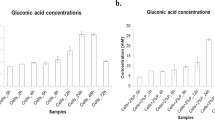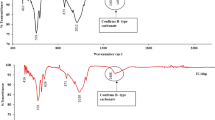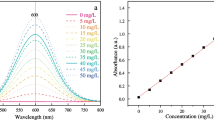Abstract
Synthesis of nanophase hydroxyapatite (HA) on a bacterial surface was achieved at the expense of CaCl2 and inorganic phosphate (Pi). After initial nucleation, calcium was precipitated on and around the cells as calcium phosphate at the expense of inorganic phosphate in the challenge solution, with no precipitation in cell-free controls. HA was also biomanufactured using inorganic phosphate ions scavenged from a phosphate-containing waste-water. With additional Ca2+, the concentration of phosphate was decreased from 0.27 (∼25 ppm) to ∼0.02m (∼2 ppm) in the waste-water. Crystals of calcium phosphate manufactured by the cells were located by scanning electron microscopy (SEM) and identified as HA by X-ray powder diffraction, with an average crystal size calculated as ∼25 nm. Possible application of bioHA as a biomaterial and implications for one-step `waste-into product' are discussed.
Similar content being viewed by others
References
Anon (1991) Commission of the European Communities. Directive Concerning Urban Waste-water Treatment (91/ 271/EEC). Official Journal,1991: L135/40.
Anon (1992) Powder Diffraction File.Card No.09-0432, JCPDS,Swarthmore,PA,USA.
Badar U, Ahmed N, Beswick AJ, Pattanapipitpaisal P, Macaskie LE (2000)Reduction of chromate by microorganisms isolated from metal contaminated sites of Karachi, Pakistan.Biotechnol.Lett. 22:829–836.
Beruto TD, Giordani M (1999)Influence of electromagnetic fields on the microstructure of precipitated calcium phosphate nanometric-grains.J.Eur.Ceram.Soc. 19: 1731–1739.
Bonthrone KM, Quarmby J, Hewitt CJ, Allan VJ, Paterson-Beedle M, Kennedy JK, Macaskie LE (2000)The effect of the growth medium on the composition and metal binding behaviour of the extracellular polymeric material of a metal-accumulating Citrobacter sp.Environ.Technol. 21:123–134.
Boswell CD, Dick RE, Eccles H, Macaskie LE (2001) Phosphate uptake and release by Acinetobacter johnsonii in continuous culture and coupling of phosphate release to heavy metal accumulation.J.Ind.Microbiol.Biotechnol. 26: 333–340.
Boudeville P, Serraj S, Leloup JM, Margerit J, Pauvert B, Terol A (1999)Physical properties and self-setting mechanism of calcium phosphate cements from calcium bis-dihydrogeno-phosphate monohydrate and calcium oxide.TJ.Mat.Sci.:Mat.Med. 10:99–109.
Cook SD, Kay JF, Thomas KA, Jarcho M (1987)Interface mechanics and histology of titanium and HA-coated tita-nium for dental implant applications.Int.J.Oral Maxill. Impl. 2:1–15.
Cranin AN, Mehrali M, Baraoidan M (1994)Hydroxylapatite-coated endosteal implants from the clinicians' perspective. J.Implantol. 20:235–239.
Dean JA,ed.(1992)Lang 's Handbook of Chemistry,14th edn.New York,USA: McGraw-Hill,Inc.
Deng X, Hao J, Wang C (2001)Preparation and mechanical properties of nanocomposites of poly(D D,L L-lactide) with Ca-defficient hydroxyapatite nanocrystals.Biomaterials 22:2867–2873.
Fernandez E, Gil FJ, Ginebra MP, Driessens FCM, Planell JA, Best SM (1999)Production and characterization of new calcium phosphate bone cements in the CaHPO4-a Ca3 (PO4 )2 system:pH,workability and setting times. J.Mat.Sci.Mat.Med. 10:223–230.
Finlay JA, Allan VJM, Conner A, Callow ME, Basnakova G, Macaskie LE (1999)Phosphate release and heavy metal accumulation by bio lm-immobilized and chemically-coupled cells of a Citrobacter sp.pre-grown in continuous culture.Biotechnol.Bioeng. 63:87–97.
Gabriel CTM, Orton DG, Hollister SJ, Feinberg SE, Halloran JW (2002)Mechanical and in vivo performance of hydroxyapatite implants with controlled architectures.Biomaterials 23:1283–1293.
Ga ¨chter R, Imboden DM (1985)Lake restoration.In:Stumm W,ed.Chemical Processes in Lakes.New York,NY: John Wiley and Sons,pp.365–388.
Gauthier O, Bouler JM, Weiss P, Bosco J, Aguado E, Daculsi G (1999)Short-term effects of mineral particle size on cellular degradation activity after implantation of injectable calcium phosphate biomaterials and the consequences for bone substitution.Bone 25:71–74.
Jarcho M (1981)Calcium phosphate ceramics as hard tissue prosthetics.Clin.Orth.Rel.Res. 157:259–278.
Jeong BC, Poole PS, Willis AC, Macaskie LE (1998)Purification and characterisation of acid-type phosphatases from a heavy metal accumulating Citrobacter sp.Arch Microbiol. 169:166–173.
Langford JI (1992)The use of the voigt function in determining microstructural properties from diffraction data by means of pattern decomposition.National Institute of Standard and Technology Special Publication 846.Proceeding of the international Conference.Accuracy in Powder Diffraction II,NIST,Gaitherburg,MD,May 26–29,pp.110–126.
Low D, Swain MV (2000)Mechanical properties of dental investment materials.J.Mat.Sci.:Mat.Med. 11:399–405.
Macaskie LE, Dean ACR (1985)Strontium accumulation by immobilized cells of a Citrobacter sp.Biotechnol.Lett. 7: 627–630.
Macaskie LE, Bonthrone KM, Yong P, Goddard DT (2000) Enzymically mediated bioprecipitation of uranium by a Citrobacter sp.:a concerted role for exocellular lipopolysac-charide and associated phosphatase in biomineral formation. Microbiology 146:1855–1867.
Mann S (1993)Molecular tectonics in biomineralization and biomimetic materials chemistry.Nature 365:499–505.
Matsuya S, Takagi S, Chow LC (2000)Effect of mixing ratio and pH on the reaction between Ca4 (PO4 )2 O and CaHPO4.J.Mat.Sci.:Mat.Med. 11:305–311.
Morse GK, Brett SW, Guy JA, Lester JN (1998)Phosphorus removal and recovery technologies.Sci.Tot.Environ. 212: 69–81.
Pattanapipitpaisal P, Mabbett AN, Finlay JA, Beswick AJ, Paterson-Beedle M, Essa A, Wright J, Tolley MR, Badar U, Ahmed N, Hobman JL, Brown NL, Macaskie LE (2002) Reduction of Cr(VI) and bioaccumulation of chromium by Gram positive and Gram negative microorganisms not previously exposed to Cr-stress.Environ.Technol. 23:731–745.
Sammons RL, Marquis PM, Macaskie LE, Yong P, Basner C (2004)Developments in the use of calcium phosphates as biomaterials.In:Valsami-Jones E,ed.Phosphorus in Environmental Technology.London: IWA,pp.582–609.
Stante L, Cellamare CM, Malaspina F, Bortone G, Tilche A (1997)Biological phosphate removal by pure culture of Lampropedia spp.Water Res. 31:1317–1324.
Suzuki K, Tanaka Y, Osada T, Waki M (2002)Removal of phosphate,magnesium and calcium from swine wastewater through crystallization enhanced by aeration.Water Res. 36: 2991–2998.
van Groenestijn JWV, Zuidema M, van de Worp MH, Deinema MH, Zehnder AJB (1989)Influence of environ-mental parameters on polyphosphate accumulation in Acinetobacter sp.Antonie van Leeuwenhoek 55:67–82.
Vaz L, Lopes AB, Almeida M (1999)Porosity control of hydroxyapatite implants.J.Mat.Sci.:Mat.Med. 10:239–242.
Yeong KCB, Wang J, Ng SC (2001)Mechanochemical synthesis of nanocrystalline hydroxyapatite from CaO and CaHPO4.Biomaterials 22:2705–2712.
Yong P, Macaskie LE (1995)The role of citrate as complexing ligand which permits enzymically-mediated uranyl ion bio-accumulation.Bull.Environ.Contam.Toxicol. 54:892–899.
Zhao D, Sengupta AK (1998)Ultimate removal of phosphate from wastewater using a new class of polymeric ion exchangers.Water Res. 32:1613–1625.
Author information
Authors and Affiliations
Rights and permissions
About this article
Cite this article
Yong, P., Macaskie, L., Sammons, R. et al. Synthesis of nanophase hydroxyapatite by a Serratia sp. from waste-water containing inorganic phosphate. Biotechnology Letters 26, 1723–1730 (2004). https://doi.org/10.1007/s10529-004-3744-4
Issue Date:
DOI: https://doi.org/10.1007/s10529-004-3744-4




